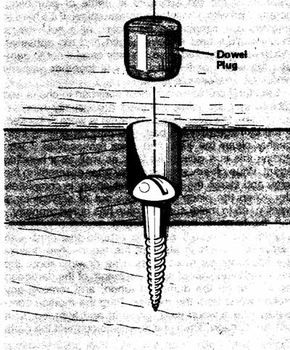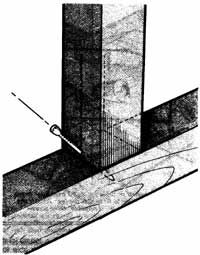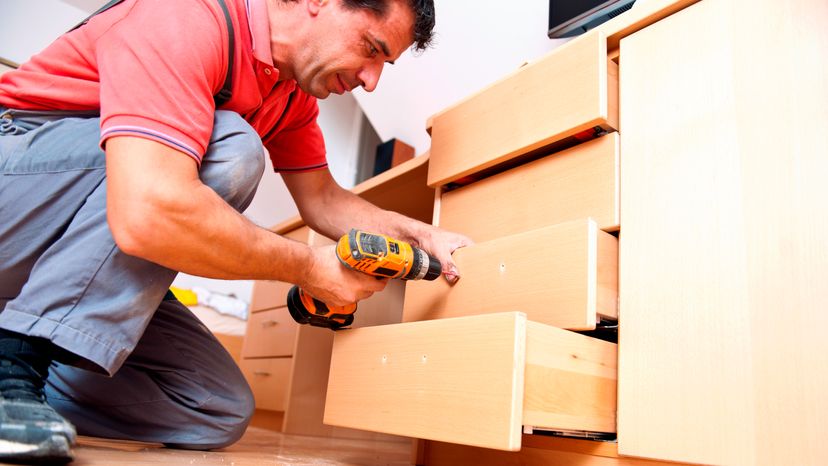
Structural problems in wooden furniture can be defined in terms of three things: the material itself, the way it's put together, and the way it functions.
The material itself is the problem when a part is broken, warped, or missing. The way it's put together is involved when joints fail or parts aren't fitted properly. The way a piece of furniture functions depends on both material and construction, and functional problems can always be traced to one or both of these sources. Nothing can turn an all-around loser into a quality piece of furniture, but with a few basic repair techniques you can handle most structural furniture problems. In this article, we'll discuss some of those techniques that can help you keep your wooden furniture in good, useable condition.
Advertisement
Rebuilding Loose Joints
When a joint fails, you have two problems to deal with: the immediate functional problem and the long-term effect of the failure on the rest of the frame. A loose joint that's not repaired today may not break tomorrow, but it will put stress on other joints. In a week's time, one wobbly leg may become two. To prevent simple structural problems from turning into more serious ones, loose or separated joints should be repaired immediately.
Gluing
The simplest solution is usually the best one, in repairs as well as in refinishing. When you discover a loose joint, first make sure the screws (if any) are tight; then try to repair it with an adhesive: plastic resin, epoxy, or resorcinol. Force the adhesive into the loose joint with a glue injector. If you can, wiggle the joint to distribute the adhesive. Clamp the joint for about two days, until the adhesive is completely cured. If possible, strengthen the glued joint with a glue block, as detailed below.
After gluing the loose joint, put the piece of furniture back into service. Check the joint again in a few weeks. If it has worked loose again, it can't be permanently repaired by regluing; you'll have to reinforce it, resecure it, or rebuild it completely.
Reinforcing: Glue Blocks and Steel Braces
Glue blocks, the original furniture braces, are solid pieces of wood used to reinforce corner joints and provide additional support. Steel corner plates and angle braces perform the same function, but they can detract from the appearance of the piece of furniture, and they can also lower its value. For this reason, glue blocks are still an important part of furniture repairs. Valuable pieces of furniture, antiques, and good reproductions should always be repaired with glue blocks instead of steel braces when possible.
Glue blocks for corner braces can be either square or triangular. Square blocks are used chiefly as outside support braces or on long joints, such as the inside corners of drawers, where cutting a triangle would be impractical. In most cases, triangular glue blocks are preferable.
Glue blocks can be cut from any square stock, but hardwood is preferred. To make a glue block, cut a square piece of wood in half diagonally. The larger the piece of wood, the greater the gluing surface of the block. The length of the blocks will depend on the project; on average, 2 inches is adequate. To strengthen chair and table legs, cut triangular braces that are as large as necessary from 1-inch nominal boards. At the right-angle corner of the block, cut off a diagonal or make a notch to fit around the leg. For braces, 1 x 2 lumber works well.
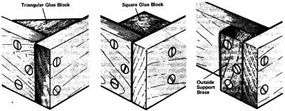
To install a triangular glue block, spread adhesive on the two right-angle sides or edges. Set the block into the corner and twist it slightly to distribute the adhesive on the bonding surfaces. Small glue blocks can be strengthened by nails driven through the block into the furniture frame; drill pilot holes for the nails to make sure you don't split the wood. To strengthen chair and table braces, drive three screws through the block and into the frame, one screw straight into the corner and one straight into each side, at an angle to the inside block edge. Predrill the screw holes for the block in both the block and the frame.
Sometimes a corner joint is held by a steel bracket instead of a glue block. If the leg wobbles, first make sure the nut that holds the bracket is securely tightened. If this doesn't solve the problem and the bracket is set into notches in the frame, it may not be seated properly. Remove the nut and reseat the bracket; then replace the nut securely.
Gluing and bracing may not be sufficient to shore up a loose joint, so you need to know other ways to handle more complicated problems. Learn some advanced repair techniques in the next section.
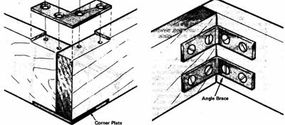
Advertisement
